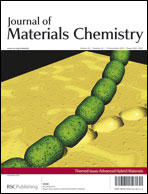Magnetism in the (Co1−xFex)2(OH)2(C8H4O4) solid solutions: a combined neutron diffraction and magnetic measurements study†‡
Abstract
The magnetic properties of the solid solution (Co1−xFex)2(OH)2(C8H4O4) x = 0.25 (1), x = 0.5 (2), x = 0.75 (3), x = 0.88 (4) and of the pure

- This article is part of the themed collection: Advanced Hybrid Materials

 Please wait while we load your content...
Please wait while we load your content...